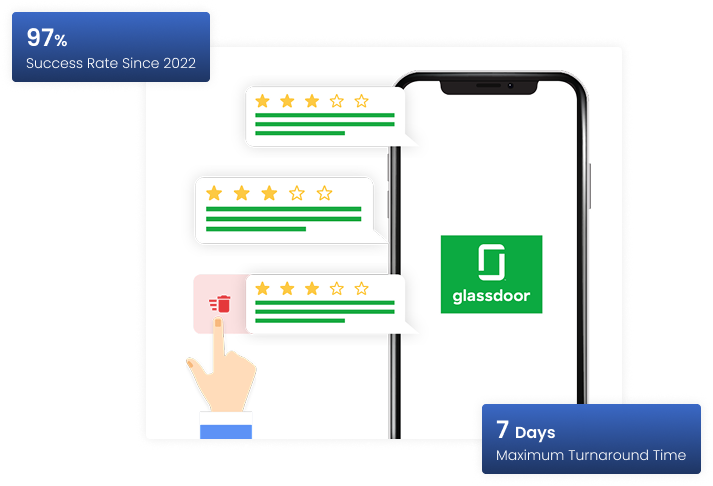
Can Companies Remove Glassdoor Reviews?
Should you care about Glassdoor reviews? Well, yes, because Glassdoor reviews aren’t just employee rants; they shape how your company is perceived. A few bad ones might not seem like a big deal, but when multiple pile up, it can drive away top talent, shake investor confidence, and cast doubt on leadership. Stakeholders, job seekers, and even competitors, all are paying close attention. Therefore, if your company’s Glassdoor page tells the wrong story, whether due to a single bad experience or an incompetent employee, it can cost you more than just good hires.
Your reputation is a currency in today’s digital age, and letting bad reviews go unchecked slowly chips away at it. This article will give you a full understanding of how to remove and handle negative Glassdoor reviews so you can take control of your company’s online reputation before it controls you.§
Table of Contents
Removing Glassdoor Reviews the straightforward way

Flagging reviews
Not every Glassdoor review is fair or even allowed under the platform’s rules. If you spot a violation, you can take action and request its removal. The key is to know what qualifies. Here’s what to look for before submitting your request:
Confidential Info
Non-public company data, including financials, strategies, or customer lists.
Identifying Individuals
Naming or negatively singling out non-C-level employees or revealing personal details.
Offensive Content
Threats, hate speech, discrimination.
Authenticity & Fair Use
Copied content, fake reviews, multiple posts. Reviewing a company they haven’t worked at in the past five years.
Misleading or Paid Reviews
Paid reviews, incentives, product focus.
Formatting & Readability
Excessive caps, poor grammar, ads.
Legal Risks
Making false statements is presented as fact.
Now that you know what to look for, here’s the step-by-step process to flag a review.
Step-by-Step Guide to Flagging Reviews

Log Into Your Glassdoor Account
Ensure you’re signed into your employer or personal account before proceeding.

Locate the Review
- Go to your company’s Glassdoor profile.
- Scroll through the reviews and find the one you want to report.

Click the “Flag as Inappropriate” Option
Below the review, you’ll see a small flag icon or a “Report” option, click it.
Select the Violation Type
Glassdoor will prompt you to choose a reason for flagging. Select the most relevant option
Provide a Detailed Explanation
- Clearly explain why the review violates Glassdoor’s policies.
- Reference specific guideline violations.
- Keep your report factual and professional.
Submit and Monitor
- After submitting your request, Glassdoor will review it.
- Check back periodically, as it may take a few days for a decision.
To increase your chances of getting a review removed, clearly identify which Glassdoor policies it violates, explain why it doesn’t meet the guidelines, and provide supporting evidence like internal documents, emails, or legal references. The more precise and well-supported your request, the better. If flagging the review doesn’t work, you can contact Glassdoor support or follow the strategies to make it work for you.
Loopholes & Gray Areas to Make It Work for You
Not all negative reviews break the rules, but that doesn’t mean you’re out of options. If a review is damaging to your business/ company’s reputation, there are still ways to challenge it, and even get it removed.
Disputing Reviews Internally with Glassdoor
If Glassdoor initially refuses to remove a review, a re-evaluation can be requested, and a well-documented follow-up can sometimes lead to a second review of the case. One effective strategy is using vague language against itself. What does that mean? Well, Glassdoor prefers reviews that are specific and have proper explanations. So, If a negative review is filled with broad statements like “horrible management”, “toxic work culture”, or “the company doesn’t care about employees”, you can argue that it lacks factual backing. A review that simply says, “The CEO is a terrible person” without details or examples doesn’t meet Glassdoor’s own standards. This way, a vague rant can be challenged and potentially removed.
Exploiting Glassdoor’s Policy Inconsistencies
Glassdoor doesn’t always apply its policies consistently, and you can use that to your advantage. If you manage to find a similar review that was removed for another company while yours remains online, you have a strong case to challenge Glassdoor’s decision. Presenting this inconsistency, you can argue to get your review removed. This approach works because Glassdoor aims to maintain fair moderation standards, and pointing out discrepancies puts pressure on them to correct their decision.
Collect as many screenshots and records of similar cases as you can, where reviews were flagged and removed. The more proof you have of policy inconsistencies, the stronger your argument becomes.
SEO Tricks to Bury Bad Reviews
If you can’t remove a bad review, the next best move is to bury it so fewer people see it. So, pushing negative reviews down in search results by flooding the internet with high-ranking positive content. Blogs, press releases, and employee testimonials can all help shift the focus away from Glassdoor. PR plays a big role, too. For instance, getting featured in reputable publications can not only increase credibility but also drown out negativity in search rankings. Plus, encouraging happy employees to leave honest reviews can tip the balance in your favor, making one bad post far less damaging.
OR you can handle it the legal way.
Glassdoor Review Removal Service
Remove Fake or Negative Glassdoor Reviews with Maximatic Media’s Online Reputation Management Service!

Legal Strategies for Removing Glassdoor Reviews

Arbitration
If your company’s employment contracts include arbitration clauses, you might have a direct path to getting a negative Glassdoor review removed. These clauses require disputes, including online reviews to be handled privately rather than on public platforms. Let’s say, if a former employee agreed to this, you have legal grounds to challenge their review. The process involves notifying the reviewer, filing for arbitration, and proving the review violates the agreement. If successful, you could secure a legally binding order for removal. However, the problem here is that not all courts uphold arbitration clauses in online defamation cases. Some jurisdictions side with the employee’s right to free speech, limiting enforcement. That’s why, before going down this path, consult legal counsel to check if your arbitration clause has the muscle to hold up.
Cease-and-Desist Letters: The First Shot Across the Bow
If arbitration isn’t an option, a cease-and-desist letter can be a strong first move. This is a formal notice that demands the reviewer to remove defamatory content or face potential legal action. Many people back down at this stage, not wanting a legal fight. While some don’t, and they may escalate the situation, claiming they’re being silenced. This is why cease-and-desist letters need to be carefully worded. A poorly handled letter can turn a quiet dispute into a PR nightmare. Again, if you’re considering this approach, work with a legal expert to ensure it’s both effective and strategic.
Defamation Lawsuits: The Nuclear Option
When a review crosses the line into false and damaging claims, you can opt for a defamation lawsuit. But it’s not a decision to take lightly. Legal action takes time, costs money, and can draw unwanted media attention. Worse, it might push the reviewer to take their complaints elsewhere, spreading even more negative press.
That said, when a company has a strong case, it can work. In one instance, a business successfully proved that defamatory reviews were harming its reputation. A court ordered Glassdoor to disclose the identities behind the anonymous reviews, leading to the removal of the harmful content. While not the easiest path, legal action can be a reliable way to remove defamatory/ negative reviews.
The Dark Side of Glassdoor: Why Black-Hat Tactics Backfire
When you can’t fix things the right way, there’s always a wrong way. But know that shady methods almost always backfire. Glassdoor actively monitors review manipulation, and when companies get caught, the fallout is far worse than just a few negative reviews.
At your own risk, here are some of the most common black-hat tactics.

Fake Legal Threats: A Weak Scare Tactic
While cease-and-desist letters have some legal basis, sending fake legal threats to former employees in the hopes they’ll panic and take their reviews down, though risky, may work. However, if a reviewer knows their rights (or talks to a lawyer), they’ll ignore the threat, or worse, publish the letter. If caught, the damage is far worse than a few negative reviews.
Review Manipulation
Some businesses, desperate for a quick fix, turn to review manipulation, here are some ways to do so, not recommended.
Buying Fake Positive Reviews
Flooding Glassdoor with five-star reviews to bury negative ones might seem like a good idea, but it’s easy to spot when a company suddenly gets a lot of generic praise with no specifics. Some even create fake employee profiles to leave positive reviews. The problem here is that Glassdoor tracks login locations, timestamps, and writing styles. If multiple accounts show suspicious patterns, Glassdoor flags and removes them.
Review Bombing Competitors:
If not me, then no one: Some take it a step further by posting fake negative reviews on competitors’ pages. But competitors can flag fraudulent reviews just like anyone else. If Glassdoor detects manipulation, the offending company faces the consequences instead. And if the competitor takes legal action for defamation, the financial and reputational fallout could be damaging.
Hacking or Unauthorized Access
Some companies get desperate; hacking ex-employee’s accounts or using inside contacts at Glassdoor to delete or edit reviews. Not only is this unethical, but it’s also illegal. Digital footprints make it easy to trace, opening the door to lawsuits, criminal charges, and a PR disaster. Sure, Black-hat tactics can get you a quick fix, but they’re reliable for the long term and are way too risky to pursue.
A strong employer brand, through social media, community outreach, and company culture initiatives can reshape public/online( here we can add a link to our other article) perception and make negative reviews lose their impact. And for that, you need an ongoing strategy to control the narrative and keep your reputation strong.
Remember, a mix of good and bad reviews is normal, and responding professionally to criticism can actually work in your favor. Instead of getting defensive, address concerns head-on. For example: “We appreciate your feedback and take concerns seriously. While we strive to create a positive work environment, there’s always room for improvement. Let’s talk, reach out to HR so we can address your concerns.”
So, can you remove a Glassdoor review? Absolutely. But even if you play by the rules, some unfair reviews still manage to slip through and stick around. Well, now you know how to handle it. That said, dealing with Glassdoor reviews on your own can feel like too much, therefore you don’t have to do it alone. Maximatic Media can help! Our agency specializes in reputation management, helping businesses remove misleading reviews from Glassdoor, strengthening employer branding, and taking control of their online presence. Feel free to reach out!
If your business is struggling with negative Glassdoor reviews, now’s the time to act!
Get in touch
Got a query that Nikolas Lemmel can help you with?
Check out other Blogs

Glassdoor Reputation Management: How to Remove Negative Reviews from Glassdoor
Nearly 86% of job seekers check Glassdoor…

How to remove bad reviews from Google My Business
Google lets customers leave reviews, whether based on real complaints, someone having …

How to Remove Negative Comments from Google
Let’s say you run a cozy local café loved by regulars and first-time visitors alike. One da…

